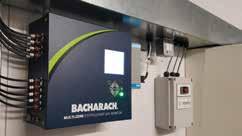
11 minute read
Refrigerant Leaks in Commercial Mechanical Equipment Rooms
BY MARK HEUCHERT, MARKETING MANAGER, DRAEGER, INC.
INTRODUCTION
Industrial and commercial refrigeration systems use different types of heat transfer fluids (HTF), many of which are toxic and/or bad for the environment when they leak. The most common HTF refrigerants are Ammonia and hydrofluorocarbons (HFC), however while ammonia has a Global Warming Potential (GWP) of 0, the HFC’s all have a very high GWPs and are currently being evaluated by the EPA for phase down as per the US Government’s December 2020 AIM Act and per the recent United States ratification of the Kigali agreement. Newly developed hyrofluoroolefins (HFO) have a lower GWP, but their flammability will need to be considered when they are integrated into the refrigeration industry.
Water combined with antifreeze solutions (such as ethylene glycol), ammonia, and liquid nitrogen are each commonly used refrigerants, keeping everything from people to perishable foods, cool and fresh. Liquid refrigerants must be carefully handled and closely monitored, whether being used for a commercial HVAC system or industrial refrigeration, because if a
leak occurs, these toxic gases can quickly become lethal. In fact, in January 2021, six workers at a poultry processing plant in Gainesville, Georgia died as a result of a liquid nitrogen leak.1
MECHANICAL ROOMS ARE EQUALLY SUSCEPTIBLE
The Gainesville tragedy is a stark reminder of the potential danger associated with refrigerants. And while it may seem unlikely, the dangers are just as real inside the mechanical room of a Grade A commercial complex as they are inside the machinery room of an industrial food processing plant.
A building’s mechanical room is the hub of its heating, ventilation, and air conditioning (HVAC) system. Mechanical rooms have numerous components, each of which can generate leaks and other issues, and may include some or all of the following: air handlers, boilers, chillers, heat-exchangers, water heaters, tanks and pumps, backup generators and elevator machinery. For this reason, a building’s mechanical room is often considered the heart of a building,2 and its safe operations are critical.
A mechanical room’s refrigeration equipment requires special attention because of its potential to leak potentially toxic and environmentally harmful refrigerant gases. Although some refrigerants have relatively low toxicity, at high concentrations they can displace oxygen. Severe or prolonged oxygen deficiency can lead to a worker’s serious injury and even death. Not only dangerous to worker health and safety, synthetic refrigerants are also controlled substances regulated by the Environmental Protection Agency (EPA) because they are considered harmful to the environment, as many refrigerants are categorized as ozone-depleting or high global warming substances.3
Industry standards provide guidelines for mechanical room operators or any person who might require access to a building’s mechanical room or its refrigerant equipment where harmful gases might be present – applicable standards include ASHRAE (American Society of Heating, Refrigerating and Air-Conditioning Engineers) 15 and 34, IIAR 2 for ammonia systems in the US, EN 378 throughout the European Union, and CSA-B52 in Canada. (Other regional and state regulations may be applicable in certain jurisdictions.) These standards outline the proper use of equipment containing refrigerants, the amount of charge for specific refrigerants, and the safe exposure limits to refrigerant gases.4
According to IIAR 2 standards, at least one ammonia detector needs to be in a machinery room, with audio and visual alarms sounding both inside and outside the room. An alarm is required to be set at a maximum of 25 ppm, with ventilation being engaged at no higher than 150 ppm. This is where a safety controller, which manages detection devices and receives alarm information and even sensor vitality data, plays a central role. Modern safety controllers are now masterless systems with modular, plug & play modules that do not require programming and can be hot swapped. These controllers can automatically engage ventilation systems, audio and visual alarms, and even send out text messages and emails when an incident occurs. It is highly recommended that the IIAR 2 standard be reviewed to make sure that all the safety requirements are properly implemented.
BENEFITS OF REFRIGERANT LEAK DETECTION
In addition to addressing the physical hazards of commercial HVAC and refrigeration systems, ASHRAE and other safety standards also stipulate the use of refrigerant gas leak detectors in mechanical rooms for commercial cooling systems with charges greater than 6.6 lbs. (3 kg) of CFC, HFC or HFO type refrigerants. EN 378 has slightly larger charge allowances.4 It’s worth noting that systems using HFO refrigerants will sometimes require detection and ventilation whether they are in a machinery room or not.
ASHRAE 15 specifically states that, 1) Each machinery room shall contain a detector located where a refrigerant leak would concentrate; and 2) The detector shall trigger an audible and visual alarm both inside and outside the mechanical room and activate mechanical ventilation.
Early detection of refrigerant leaks is essential for a variety of reasons, not the least of which is the protection of workers’ health and safety.
• Protect Health and Safety – If a piece of commercial HVACR equipment experienced a sizeable break, or fissure, it would cause an immediate and dangerous refrigerant leak, but equally dangerous are the smaller, slower leaks that could easily go undetected. A slow seeping of toxic gas within an enclosed space can accumulate to dangerous concentration levels over time.
Extended exposure to refrigerants can cause adverse cardio and neurologic health effects and in higher concentrations even cause asphyxiation. Gas detection devices provide workers an early warning of potential danger. • Reduce Waste – Synthetic refrigerants are expensive, so a leak of any scale can be costly to a commercial enterprise. Refrigerant loss can also affect a system’s operating efficiency and risk the loss of salable products.
The sooner a leak is detected, the sooner it can be repaired, and any waste and economic loss mitigated. • Minimize Refrigerant Emissions – EPA standards dictate that mechanical rooms use detectors to minimize refrigerant leaks and protect the environment from harmful emissions.
To remain compliant, commercial buildings must have specialized detection systems capable of identifying low level leaks. • Prevent Unplanned Shutdowns –
Every operations manager knows an emergency or unforeseen system outage is costlier and more inconvenient than a planned shutdown for scheduled maintenance or testing. Early leak detection allows maintenance workers to intentionally shut down and shore up their system until they can adequately plan to repair leaks or replace damaged equipment.
DIFFUSION GAS DETECTION VS. SAMPLING SYSTEMS
For mechanical room operators – whose job it is to select an appropriate and effective gas detection system for their unique space and HVACR system – it is important to understand the distinction between refrigerant gas detection for the purpose of protecting workers’ safety and early leak detection for the purpose of reducing refrigerant emissions and satisfying environmental regulatory standards.4
Diffusion-style gas detectors are typically used to meet mechanical room safety requirements. They are commonly wall-mounted; thus, a gas leak must travel to reach the sensor element. Naturally, gases become less concentrated as they move from the point of a leak to the location of gas detection, but once sensors detect even low concentrations, detectors will quickly sound an alarm. It is important to install diffusion style detectors in the proper location and height, depending on the application and gas type that is being monitored.
Diffusion detectors often include a gas sensor with a lower detection limit (LDL) of 20 ppm and preset alarm settings of 15% to 100% of the full-scale range. An early low alarm warning level reduces false alarms while still providing for a safety factor before reaching the threshold of the occupation exposure limit (OEL) which is the setpoint of the typical high alarm setting.4
Leak detectors are designed to warn technicians or other commercial building employees that refrigerant gases exceed safe concentration levels before they enter a mechanical or machinery room. As previously noted, ASHRAE guidelines stipulate that to protect workers a gas detector should be located in an area where the refrigerant gas from a leak will concentrate. Additionally, gas detectors must set off an audible and visual alarm and automatically trigger mechanical ventilation.
While diffusion-style detectors identify higher gas concentrations and comply with safety guidelines set forth







by ASHRAE and other industry regulators, they are insufficient at detecting low-level leaks. Ultra-sensitive gas sampling systems provide continuous monitoring of air quality, and thus can provide early warning of smaller refrigerant leaks that contribute to harmful refrigerant emissions.
Sampling systems use sensitive, centralized photoacoustic infrared gas sensors with an LDL as low as 1 ppm. A pump is used to draw samples from points as close as possible to a potential leak source – for example, coils or com-
pressors, to the sensor. Such sequential sampling systems are ideal for commercial building applications where there are multiple, dispersed sources of potential leaks and where gases can become quickly diffused in the large spaces.
Photoacoustic infrared based sampling systems are also recommended for detection of refrigerants such as R123 where the required alarm setpoints are lower than the LDL of diffusion style gas sensors.
CHOOSING A GAS MONITORING SYSTEM
It would not be practical for a mechanical room operator to only monitor for low level refrigerant leaks and neglect methods that warn of a build-up of higher gas concentrations – nor would it be prudent to focus only on worker safety and ignore EPA compliance. Instead, commercial mechanical rooms must have a robust gas detection system capable of effectively and efficiently performing both monitoring methods.
Multiple manufacturers offer a variety of refrigerant gas detector and monitoring systems designed for refrigerant applications in mechanical rooms. They all have their advantages and limitations. When evaluating systems, it is important to examine key capabilities. Here are few critical considerations: • Is the monitoring system compliant with standards?
• At what ppm level does the detector register the presence of gas? • Are the sensors specific to the target gas and not cross sensitive to other gases such as cleaning agents? • Does the system include multi-point monitoring? Can it be expanded?
• Does the controller have multiple relays for fault and alarm alerts, as well as connection to a visual and audible alarm required by standards? • Does the system controller include integrated BACnet or Modbus for direct digital communication to the facility’s building management or refrigeration control system? • Is the system intelligent enough to include plug-and-play capability, eliminating the need for timeconsuming configuration.3 • Does the manufacturer offer factory trained and authorized on site commissioning and preventative maintenance service?
There are a variety of gas detection instruments – from personal portable detection devices to wall-mounted stationary units. The purpose of fixed gas detection in these applications is to alert workers of a dangerous situation before they enter and while working in the space. HFC, HCFC, and HFO refrigerants are usually detected using NDIR (Non-Dispersive Infrared) sensors and Photoacoustic IR sensors. Depending on the performance capabilities of the sensor, one can expect an LDL (Lower Detection Limit) of 20 ppm with a range of 0-2000 ppm. Another sensor technology using catalytic beads can detect ammonia and other combustible gases from 0-100% LEL (Lower Explosive Limit). There are other technologies such as MOS (Metal Oxide Semiconductor) which are lower cost but are not specific to refrigerants and can generate false alarms due to cross interference with common household cleaners. It is important to meet with a gas detection consultant to determine which sensors are needed and where to place them, which is determined by the application.
CONCLUSION
Refrigerant gases can be toxic to workers and damaging to the environment. Thus, refrigerant gas safety is important – not just in industrial settings, but in commercial environments as well. Gas monitoring is essential to protect the health and safety of workers, to mitigate costly leaks and potential emergency shutdowns, and to reduce harmful emissions and comply with environmental regulations. Both safety and emissions matter, so gas detection systems must address small, moderate, and high-level leaks.
ABOUT THE AUTHOR
Mark Heuchert serves as Marketing Manager, North American region, for Dräger, an international leader in the fields of medical and safety technology.
REFERENCES
1 https://www.nytimes.com/2021/01/28/us/ foundation-food-group-liquid-nitrogen-plant. html
2 https://www.us.jll.com/en/views/anexceptional-mechanical-room-shares-a-frontof-house-mindset
3 https://www.ishn.com/articles/108548control-refrigerant-gas-in-hvac-mechanicalequipment-rooms 4 https://ss-usa.s3.amazonaws. com/c/308475912/media/4680601c515 ebf80b79603880819469/Machinery%20 Rooms%20Whitepaper.pdf https://www.honeywellanalytics.com/~/media/ honeywell-analytics/documents/english/ apn068_mechanicalrooms_web_10-15-14. pdf?la=en







